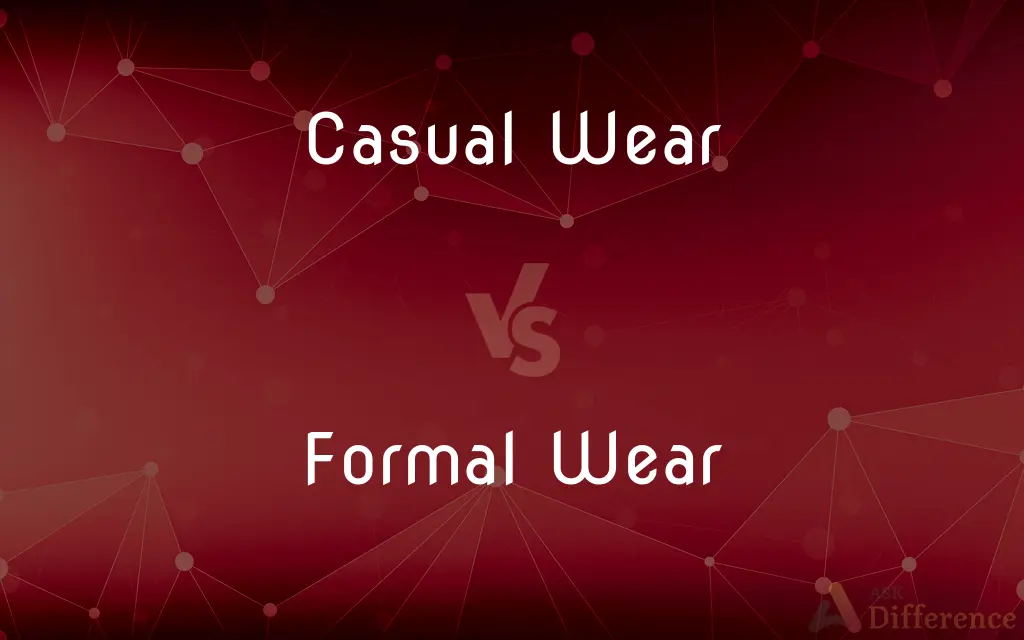Casual Wear vs. Formal Wear — What's the Difference?
By Tayyaba Rehman — Published on November 22, 2023
Casual Wear is relaxed and comfortable clothing suitable for everyday use, while Formal Wear is sophisticated attire typically reserved for special occasions or professional settings.

Difference Between Casual Wear and Formal Wear
Table of Contents
ADVERTISEMENT
Key Differences
Casual Wear denotes attire that emphasizes comfort, relaxation, and individuality. On the other hand, Formal Wear implies a standard of dress that showcases elegance, professionalism, and often adheres to a stricter dress code.
While Casual Wear is commonly adopted for everyday activities, hangouts, or less structured events, Formal Wear is the go-to choice for ceremonies, formal gatherings, and professional environments. The intention behind Casual Wear is to provide ease and freedom, while Formal Wear emphasizes a polished and refined appearance.
Jeans, T-shirts, and sneakers are staples of Casual Wear, offering a laid-back look. In contrast, Formal Wear often consists of suits, ties, formal dresses, and polished shoes, projecting a sense of decorum and seriousness. The materials and craftsmanship involved also differ; Casual Wear can be made of any comfortable material, while Formal Wear usually involves finer fabrics and meticulous tailoring.
The decision to wear Casual or Formal attire can be influenced by the event, societal norms, or personal preference. While Casual Wear allows for more personal expression and variety, Formal Wear, despite its restrictions, offers an opportunity to display sophistication and adherence to established norms.
Interestingly, the line between Casual Wear and Formal Wear has blurred in recent decades, with many adopting "business casual" or integrating elements of both in their outfits. This reflects evolving societal norms and the fusion of comfort with formality.
ADVERTISEMENT
Comparison Chart
Primary Purpose
Comfort and relaxation.
Elegance and professionalism.
Typical Occasions
Everyday activities, hangouts.
Ceremonies, formal events, professional settings.
Common Items
Jeans, T-shirts, sneakers.
Suits, ties, formal dresses, polished shoes.
Fabric and Craftsmanship
Any comfortable material, varied craftsmanship.
Finer fabrics, meticulous tailoring.
Expression
Personal and varied.
Adherence to established norms.
Compare with Definitions
Casual Wear
Relaxed attire without strict dress codes.
For the weekend trip, her Casual Wear consisted of a sundress and sandals.
Formal Wear
Clothing adhering to stricter dress codes.
The event required Formal Wear, so she wore a long, elegant gown.
Casual Wear
Wardrobe choices that prioritize ease and freedom.
Her Casual Wear collection was filled with colorful and comfortable pieces.
Formal Wear
Attire showcasing elegance for special occasions.
He donned his best Formal Wear, a sharp black tuxedo, for the gala.
Casual Wear
Outfits suitable for informal settings.
Casual Wear is ideal for a relaxed evening with friends at a cafe.
Formal Wear
Sophisticated attire usually involving meticulous tailoring.
Her Formal Wear for the wedding included a tailored dress and heels.
Casual Wear
Everyday clothing emphasizing personal style.
Graphic tees are a popular choice for Casual Wear among teenagers.
Formal Wear
Outfits projecting decorum and professionalism.
For the business meeting, he chose Formal Wear, including a suit and tie.
Casual Wear
Clothing emphasizing comfort for daily activities.
He opted for Casual Wear, choosing a hoodie and jeans for the outing.
Formal Wear
Clothing choices that reflect societal norms for upscale events.
At the awards ceremony, everyone was expected to be in their finest Formal Wear.
Common Curiosities
What's the primary intention behind Casual Wear?
Casual Wear prioritizes comfort, relaxation, and personal expression.
Can jeans be considered Formal Wear?
Typically, jeans are categorized as Casual Wear, but certain settings may accept dark, well-fitted jeans as "business casual."
Can a dress be considered Casual Wear?
Yes, there are casual dresses that prioritize comfort and are suitable for everyday activities.
When is Formal Wear typically worn?
Formal Wear is usually reserved for ceremonies, formal gatherings, and professional settings.
Can sneakers be part of Formal Wear?
Traditionally, sneakers are Casual Wear, but fashion evolutions have seen them paired with more formal outfits in certain settings.
What fabrics are commonly associated with Formal Wear?
Formal Wear often involves finer fabrics like silk, wool, and satin.
Does Formal Wear always require a tie?
Not always. While ties are common in men's Formal Wear, certain events or styles might not necessitate one.
Can I wear a T-shirt as Formal Wear?
Traditionally, T-shirts are considered Casual Wear. However, a well-fitted, solid-color T-shirt under a blazer might pass in some "business casual" settings.
Is Casual Wear suitable for a business meeting?
It depends on the company's dress code; some companies might accept "business casual," while others demand strictly Formal Wear.
What's "business casual"?
It's a blend of Casual and Formal Wear, often involving items like dress shirts, slacks, and dresses without the strict formality of a suit or gown.
Are there any color restrictions for Casual Wear?
No, Casual Wear offers freedom in color choices, whereas Formal Wear might have more traditional color norms.
Is Casual Wear more affordable than Formal Wear?
Generally, Casual Wear can be more affordable, but there are luxury casual brands. Formal Wear often involves finer materials and craftsmanship, which can be pricier.
Does Formal Wear always mean wearing a suit?
For men, a suit is a common choice for Formal Wear, but other options like tuxedos or cultural attire might also be acceptable.
Share Your Discovery

Previous Comparison
Sources vs. Resources
Next Comparison
Super Retina vs. Liquid RetinaAuthor Spotlight
Written by
Tayyaba RehmanTayyaba Rehman is a distinguished writer, currently serving as a primary contributor to askdifference.com. As a researcher in semantics and etymology, Tayyaba's passion for the complexity of languages and their distinctions has found a perfect home on the platform. Tayyaba delves into the intricacies of language, distinguishing between commonly confused words and phrases, thereby providing clarity for readers worldwide.













































